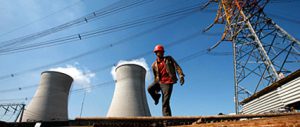This summer, Chinese people have been thinking twice before turning on their air conditioners.
In July, tiered electricity pricing came into effect across China, except in the far western regions of Tibet and Xinjiang. This means the people who consume the most electricity will also be charged higher prices for it.
A household using 500 kilowatt hours of electricity per month, will pay an extra 474 yuan (US$74.6) a year under the new pricing system, which sells itself as a sort of Robin Hood initiative. The Chinese government estimates that 5% of the population – the very highest earners – account for 24% of domestic electricity consumption in China, while the top 10% use 33% of electricity. The idea is that tiered pricing will spread the load more fairly, in line with ability to pay.
The same principle has already been applied in the water sector. On February 1, Changsha, the capital city of Hunan province, became the first city to introduce a system of staggered water prices. It also raised water prices for the majority from 1.88 yuan to 2.58 yuan per tonne. Seventeen major cities have since followed suit. Twenty cities, including Guangzhou, Hainan, Chongqing, Wuhan and Guilin are holding hearings on similar plans.
Along with the quick and resolute reforms in the water and electricity markets, there are also signals that long overdue reform of fuel pricing is in the offing. In 2009, China’s top economic planning body, the National Development and Reform Commission (NDRC), established a new pricing mechanism for fuel, which has been widely criticised as opaque and incapable of adjusting prices often enough.
During this year’s “Lianghui” – China’s annual parliamentary session – NDRC deputy Peng Sen said a new mechanism would be determined this year, once international crude prices had stabilised at a lower level. With international oil prices coming down and expected to continue to do so in the near term, analysts anticipate that this new mechanism will come into effect in the third quarter of the year.
On July 3, trading of natural gas started on the Shanghai Petroleum Exchange. This is the first time that China has used the market to moderate peak demand, and industry insiders regard it as a trial for further market pricing reforms. Liu Tienan, director of the National Energy Administration (NEA) and deputy director of the NDRC, said that tiered water and electricity price reforms are taking the lead, with “big reforms” of coal and fuel to follow.
Timing right for reform
Changes to water, electricity and fuel prices affect the cost of living and as a result will have a real impact on people’s lives.
Crude oil prices have been falling this year, thanks to the global economic slump, and fuel prices in China have followed suit. After a “golden decade”, even the cost of coal has plummeted. Grocery costs have fallen too, and year-on-year increases in the monthly consumer price index may drop below 3%. These declines have given China a window of opportunity for relatively easy implementation of price reforms.
In addition, the country is under a lot of pressure to save energy and cut emissions, while overarching development strategies call for restructuring – all of which mean that the time is right for price reforms.
Although China has gradually increased the role of the markets over the last 30 years, key resources and commodities such as water, electricity and fuel remain part of the planned economy. The price anomalies this creates have caused shortages of electricity, natural gas and oil, hampering economic development.
On New Year’s Day, 2010, uncommonly cold weather caused a spike in electricity consumption in Shandong province, east China – but coal stocks could only sustain that level of consumption for nine days. Without coal to burn, electricity had to be cut off. “This is the difference between ‘market coal’ and ‘planned coal’,” said an official at Shandong Electricity Group. As coal prices are now set by the market, while electricity prices are set by the state, high coal prices result in losses for the generating companies. To reduce losses, they generate less electricity, and that means shortages at peak times.
Even more important is the fact that, since 2009, more than 50% of China’s crude-oil consumption has been fed by imports; while natural gas and coal imports are also rising annually. Add in China’s low per-head water resources, increasing resource shortages and muted energy prices, and you end up with a bottleneck for economic development.
Price reform or price hike?
Central government officials have made it clear that the purpose of price reforms is to use market mechanisms to allocate resources, and that they should not be regarded as straight price increases. But all the hearings on water and electricity price reform have, in the end, resulted in higher prices.
People who use more electricity pay more, while energy-savers haven’t seen any extra savings. Outside of the cities where tiered pricing has been introduced, average price increases have been above 30%. The new fuel-price mechanism is likely to result in similar hikes.
“In China, public resource prices have always been quite low. When reforming price relationships it may seem there are more price hikes than cuts,” said Lin Boqiang, director of Xiamen University’s Centre for China Energy and Economic Research. “But an important factor in the success of the reforms will be achieving fair and reasonable price mechanisms while doing so.”
The NDRC’s plans will ultimately see market pricing for water and fuel. This will involve a process of price rises to reflect actual resource value, accompanied by reforms in both resource taxes and resource compensation fees.
Professor Chen Hua from Shandong University of Finance and Economics participated in the hearings on tiered electricity pricing in Shandong. He said: “Resources like water, electricity and fuel are both market commodities and public goods, and prices impact on the interests of everyone. So price reforms need to ensure that low-income households aren’t too badly affected. Reform design needs to be detailed, ensuring that special populations are taken care of, and that the basic needs of the people aren’t threatened.”
He continued: “A series of price changes coming close together won’t help economic stability.And it isn’t realistic to think they’ll get everything right the first time. But whatever price changes are made, they should be made openly and transparently. Which price increases should be borne by citizens? Which shouldn’t? How big a rise is reasonable? The public will only accept and approve of price reforms when this is made clear.”
This article is based on a story that first appeared in Shandong Evening Times, where Cui Bin is a reporter.
This article is part of our Green Growth project, a collaboration between chinadialogue and the Energy Foundation
Homepage image by nordicdesign



